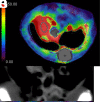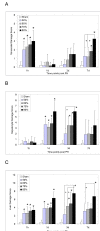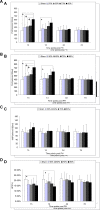Quantitative study of liver hemodynamic changes in rats with small-for-size syndrome by the 4D-CT perfusion technique
- PMID: 31017448
- PMCID: PMC6592094
- DOI: 10.1259/bjr.20180847
Quantitative study of liver hemodynamic changes in rats with small-for-size syndrome by the 4D-CT perfusion technique
Abstract
Objective: The microcirculatory hemodynamic changes of small-for-size syndrome (SFSS) are still unclear. In this study, they were investigated by four-dimensional CT perfusion (4D-CTP) technique.
Methods: The sham group, 50, 60, 70 and 80 % partial hepatectomy (PH) rat groups were established. At 1 hour (1 h), 1 day (1 d), 3 days (3 d) and 7 days (7 d) post-operation, serological examination, 4D-CTP scan and histopathological examination were performed. One-way analysis of variance and the Kruskal-Wallis test were used for the comparison.
Results: Based on the diagnostic criteria of SFSS, the 80 % group was considered to be a successful model. In all the PH groups, portal vein perfusion and total liver perfusion peaked at 1 h and declined at 1d and 3d. Both portal vein perfusion and total liver perfusion were significantly higher in the 80 % group than the sham group, 50 and 60% groups at 1 h (p < 0.05), and 80 % group at 3d and 7d (p < 0.05). In the 50 and 60 % groups, hepatic artery perfusion decreased at 1 h and maintained at a lower level until at 7 d; whereas, in the 70 and 80% groups, it increased at 1 h, then decreased and reached the lowest level at 7 d. No significant difference appeared in hepatic artery perfusion between any two groups at any time points. At all time points, hepatic perfusion index was lower in all the PH groups than the sham group. Significant differences in hepatic perfusion index appeared between the 80% group and the sham group at 1 h and 1 d (p < 0.05).
Conclusions: The CTP parameters quantitatively revealed the microcirculatory hemodynamic changes in SFSS, which were further confirmed to be associated with histopathological injury. It is suggested that the hemodynamic changes in SFSS remnant liver can provide useful information for further revealing the mechanism of SFSS and may help for guiding the treatments.
Advances in knowledge: By using the 4D-CTP technique, the hepatic microcirculatory hemodynamic changes could be quantitatively measured in vivo for small animal research.
Figures





Similar articles
-
Extracorporeal continuous portal diversion plus temporal plasmapheresis for "small-for-size" syndrome.World J Gastroenterol. 2013 Sep 7;19(33):5464-72. doi: 10.3748/wjg.v19.i33.5464. World J Gastroenterol. 2013. PMID: 24023489 Free PMC article.
-
[A Preliminary Study on Portal Vein Hemodynamic Changes and Liver Regeneration in Rats after 70% Partial Hepatectomy].Sichuan Da Xue Xue Bao Yi Xue Ban. 2016 May;47(3):326-30. Sichuan Da Xue Xue Bao Yi Xue Ban. 2016. PMID: 27468474 Chinese.
-
[Effect of perfusion CT scan on hepatic hemodynamic changes in rats with liver micrometastases].Ai Zheng. 2006 Jul;25(7):849-54. Ai Zheng. 2006. PMID: 16831276 Chinese.
-
Computed tomography perfusion in living donor liver transplantation: an initial study of normal hemodynamic changes in liver grafts.Clin Transplant. 2009 Sep-Oct;23(5):692-9. doi: 10.1111/j.1399-0012.2009.00991.x. Epub 2009 May 15. Clin Transplant. 2009. PMID: 19473203
-
A critical appraisal of the hemodynamic signal driving liver regeneration.Langenbecks Arch Surg. 2012 Apr;397(4):579-90. doi: 10.1007/s00423-012-0913-0. Epub 2012 Feb 7. Langenbecks Arch Surg. 2012. PMID: 22311102 Review.
References
-
- Scatton O , Cauchy F , Conti F , Perdigao F , Massault PP , Goumard C , et al. . Two-stage liver transplantation using auxiliary laparoscopically harvested grafts in adults: Emphasizing the concept of "hypersmall graft nursing" . Clin Res Hepatol Gastroenterol 2016. ; 40 : 571 – 4 . doi: 10.1016/j.clinre.2016.03.002 - DOI - PubMed
-
- Gyoten K , Mizuno S , Kato H , Murata Y , Tanemura A , Azumi Y , et al. . A novel predictor of posttransplant portal hypertension in Adult-To-Adult living donor liver transplantation: increased estimated Spleen/Graft volume ratio . Transplantation 2016. ; 100 : 2138 – 45 . doi: 10.1097/TP.0000000000001370 - DOI - PMC - PubMed

